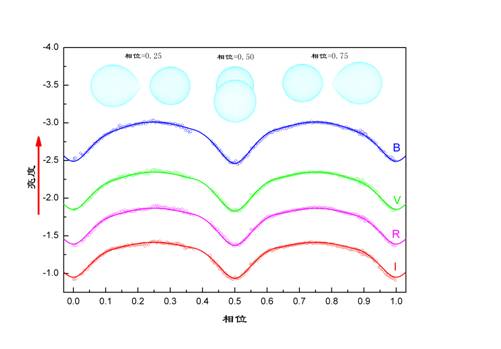In close binary systems, it is believed that, at a certain point during the evolution process, the constituent stars undergo mass exchange. This process changes the masses of the constituent stars, thereby modifying their evolution process. This significantly distinguishes binary evolution from that of independent single stars, and is a major contributor to atypical objects and physical phenomena. Recently, one of our groups, headed by Professor Shengbang Qian, observed a binary system that was undergoing the mass exchange evolutionary phase at the time of observation, providing decisive evidence of the existence of such mass exchange processes. The work was published (2013, ApJS, 207, 22).
According to prevailing binary evolution theories, in a detached binary system, the more massive star will evolve faster, fill the Roche Lobe before its companion, and start transferring mass onto the latter. This mass exchange process results in a proclivity for the masses of the two stars to approach each other, and also in a decreasing orbital period. When the mass ratio between the stars equals 1, the orbital period reaches its minimum. After this benchmark, the formerly less massive star will continue to grow, since although it is now more massive, the Roche Lobe overflow timescales are too short to allow it to evolve to fill its own Roche Lobe in turn. Observing a binary system in its mass ratio = 1 state is critical as a key test for this theory. However, due to the short timescales of the overflow, such an observation has yet to be made up to this point.
V753 Monoceros is a close binary system consisting of 2 A-type stars, with an orbital period of  s. Since 2006, Shengbang Qian et al. have been monitoring the binary, obtaining 18 local minima in the luminosity curve in the process. In January 2011, they obtained a complete period of the luminosity curve in the B, V, R, and I bands (plotted below). Through analyzing the luminosity curve, it was found that the binary was a semidetached binary in which the less massive star had already filled its Roche Lobe. Also, the constituent stars had a very similar mass (1.597 and 1.647 solar masses respectively). The semidetached structure of the binary and the increasing length of its orbital period reveal its nature as a binary in which mass is being transferred from the less massive star to the more massive one. These results show that V753 Monoceros is a binary that is at mass ratio = 1, and the only one of its kind ever to be observed by mankind.
s. Since 2006, Shengbang Qian et al. have been monitoring the binary, obtaining 18 local minima in the luminosity curve in the process. In January 2011, they obtained a complete period of the luminosity curve in the B, V, R, and I bands (plotted below). Through analyzing the luminosity curve, it was found that the binary was a semidetached binary in which the less massive star had already filled its Roche Lobe. Also, the constituent stars had a very similar mass (1.597 and 1.647 solar masses respectively). The semidetached structure of the binary and the increasing length of its orbital period reveal its nature as a binary in which mass is being transferred from the less massive star to the more massive one. These results show that V753 Monoceros is a binary that is at mass ratio = 1, and the only one of its kind ever to be observed by mankind.
On a separate note, the periodic change in the orbital period hints at the existence of a third companion star in the system, with a lower mass limit of 0.16 solar masses.
